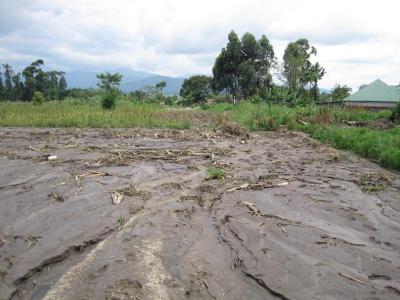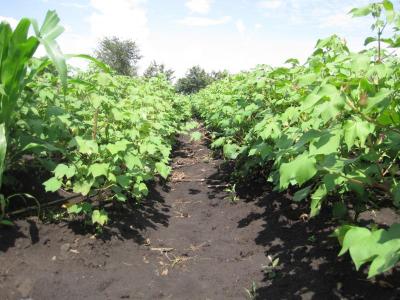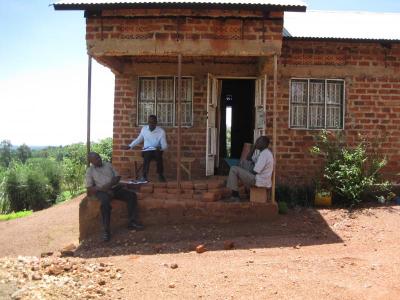Exploring the possibility of measuring the Adaptive Capacity of cooperatives and their farmers to the Impacts of Climate Change in Eastern Africa
There is a clear cause-and-effect relationship between poverty, environmental degradation and the impacts of climate change (1). Environmental degradation leads to poverty. On the contrary, poverty is a usual cause of environmental degradation as it weakens people’s capacity to manage resources wisely. Further, the impacts of climate change, e.g. increased droughts in Central and North East Kenya, uncontrollable flooding’s in South West Uganda (picture 1 and 2), will cause population displacements in a region where land tenure systems and gender inequality are prominent.

 Picture 1 and 2: The pictures illustrate the issues of flooding’s as a result of the impacts of climate change in South Eastern Uganda. One of We Effect’s partner organisations is active in this region. Pictures: 21.11.2012, Madeleine Jönsson.
Picture 1 and 2: The pictures illustrate the issues of flooding’s as a result of the impacts of climate change in South Eastern Uganda. One of We Effect’s partner organisations is active in this region. Pictures: 21.11.2012, Madeleine Jönsson.
A prerequisite for sustainable development is local ownership, responsibility and accountability, which is why We Effect strives to work in partnership with local organisations. The main We Effect approach and method is to support and facilitate organisational development and capacity building in partner organisations. This is achieved through the provision of technical assistance, training and advisory services in the defined programmes, methods and technical know-how as well as funding. For instance, We Effect’s Rural Development Programme of East Africa is working together with eight member-based organisations, reaching out to a total of approximately 191,335 farmers, 141,592 men and 49,743 women.
Based on the on-going We Effect supported project activities within the Rural Development Programme, particularly farmers the region, have testified to unreliable rainfall, prolonged droughts and floods. We Effect’s Environment and Climate Change goal is: “Right to a safe, healthy environment in ecological balance” (We Effect’s global strategy 2013-2015). As from 2012, the organisation started to focus on an improved monitoring of Environmental and Climate Change impacts within We Effect’s programmes and amongst our partner organizations. This monitoring is an essential step to achieve the goal and concretely integrate environment and climate change impacts into We Effect’s programmes and our partner’s work. In addition, the purposes of the monitoring are (1) to reduce farmers’ vulnerability to the risks caused by climate change and (2) to increase farmers’ ability to adapt to the impacts of climate change.
We Effect has developed two surveys that we are using as tools to gather the data: (1) The production survey, used at a farmer level and; (2) the processing survey, used at an organisation level.
The Production Survey
The purpose of the production survey is for We Effect and partner’s to be able to assess the adaptation rate of their farmers to various impacts of climate change. The methodology and hence indicators to measure the adaptation rates of farmers with regards to climate change adaptation are for Sustainable Land Management (SLM)/Sustainable Agricultural Land Management (SALM) practices. The parameters of the survey are specifically designed to illustrate the number of farmers implementing SALM practices and the number of farmers using improved/new water techniques. Picture 3 illustrates and example of a soil and water conservation technique from one of We Effect’s partner organisations.
 Picture 3: Ridges and furrows demonstration plot set up by Nyakatonzi Growers Co-operative Union Limited (NGCU), a soil and water conservation technique. Picture: 21.11.2012, Madeleine Jönsson.
Picture 3: Ridges and furrows demonstration plot set up by Nyakatonzi Growers Co-operative Union Limited (NGCU), a soil and water conservation technique. Picture: 21.11.2012, Madeleine Jönsson.
The production survey aims at answering the following questions: (1) how are the right-holders coping with climate change? (2) Where are the gaps, mainly with regards to SALM practices and water usage? (3) Are the impacts of climate change experienced differently by women and men? If yes, how? (4) Are the adaptation solutions different when it comes to gender? If yes, how and why? (5) In what areas does the right-holders need stronger capacity building, e.g. in SALM practices? Why are they not adapting to different practices? (6) Are they experiencing food and water shortages during the year? (7) What risks are the right-holders exposed to with regards to climate change? Does it differ per gender? And (8) Where are the possible and key interventions with regards to productivity?
The Processing Survey
The purpose of the processing survey aims at analysing the impact of the processing part of the value chain, e.g. the milling sites, on the environment. The processing survey aims at answering the following questions: (1) how are managers coping with climate change and how is the processing sites impacting on the environment? (2) Where are the gaps? (3) Where are the possible and key interventions for the processing sites? And (4) is there a way we can reduce variable costs with such interventions?
Where are we now?
The baseline monitoring is presently being carried out with small-scale farmers in coffee and dairy value chains in Kenya, Tanzania and Uganda by different partner organisations, amongst others Uganda Crane Creameries Cooperative Union (UCCCU), MVIWAMO in Tanzania and We Effect’s Kenya Country Project: Farmers’ Organisation in Poverty Alleviation (FOPA) in Kenya. We are using a sampling methodology developed by the World Bank and based on the total population size, each partner organisation is interviewing on average 370 farmers. In total, We Effect in cooperation with our partner organisations will have interviewed approximately 1,800 farmers by mid-2013. Picture 4 shows part of the monitoring process in Uganda, together with one of our Ugandan partners, UCCCU.
 Picture 4: Interview with a small-scale dairy farmer in Mbarara district, South-West Uganda. Picture: 10.04.2013 , Madeleine Jönsson.
Picture 4: Interview with a small-scale dairy farmer in Mbarara district, South-West Uganda. Picture: 10.04.2013 , Madeleine Jönsson.
In addition, we are developing an on-line database, where our partner organisations will be able to key in the survey results. The database will be able to develop reports directly connected to the purpose and sub-aims of each monitoring process. The results will be used on various levels: (1) for key interventions in the communities; (2) to use the results to develop new and stronger partnerships with donors and other stakeholders and; (3) for research purposes.
Monitoring – A crucial procedure to achieve our impact
At present, these are pilot projects. It is our objective that all partner organisations with the Rural Development Programme should do the monitoring on a yearly basis. This will increase our understanding of how small-scale farmers and cooperative unions are experiencing and adapting to the impacts of climate change and where it is our rightful mandate to intervene. We have understood that in order to achieve our set targets, baselines and progressive surveys are crucial. Monitoring is hence a large part of We Effect’s work enabling us, together with our partner organisations to demonstrate and achieve our impact.
Biography
Madeleine Jönsson is currently working as an Environment and Climate Change Officer at We Effect’s Regional Office for Eastern Africa based in Nairobi. Her main role is to mainstream and integrate Environmental Sustainability and Climate Change into We Effect’s programmes.
For 55 years, We Effect (formerly Swedish Cooperative Centre) has worked for a sustainable and just world free from poverty and our change of name will not detract from that. We Effect is a decentralised organisation where development cooperation is managed at the regional level. The vision for We Effect’s development work is “A sustainable and just world free from poverty”. We Effect seeks to contribute to this by supporting poor women and men to enable them to increase their incomes, improve their living conditions, defend their rights, and organise themselves.
For further readings on SLM/SALM:
FAO, 2011, Sustainable Land Management in Practice, Guidelines and Best Practices for Sub-Saharan Africa, Field Application, FAO, 2011, ISBN 978-92-5-000000-0, http://www.fao.org/docrep/014/i1861e/i1861e.pdf
The World Bank, 2008, Managing Land and Landscapes, A Sourcebook, Advance Web Edition, http://siteresources.worldbank.org/INTARD/927371-1205790395237/21689740/SourcebookMarch08.pdf
The World Bank, 2011, Approved VCS Methodology VM0017, Version 1.0, Sectoral Scope 14, http://wbcarbonfinance.org/docs/VM0017-SALM-Methodolgy-v1-0.pdf
References
Berlekom, M., Engstrom, L., Eriksson, M.L., Gallardo, G., Gerhardt, K., Knutsson, P., Malmer, P., Stephansson, E., Von Walter, S., 2009. Natural resource Tenure – a crucial aspect of poverty reduction and human rights, Sida studies 23, 2009. ISBN: 978-91-586-8143-9.